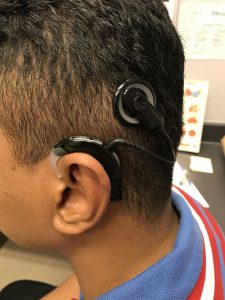Hearing Loss
Hearing loss could be divided to whether conductive hearing loss or sensorineural hearing loss. In conductive hearing loss any component in the sound travelling pathway from external environment to ear canal, tympanic membrane, ossicles to oval window might be affected. Then when the sound reach the sensory organ, hair cell in cochlear will generate impulse and the impulse would be transmitted via the cochlear nerve to the brain. Diseases affecting the hair cell and the neural pathway will cause sensorineural hearing loss.
Hearing loss is a common problem especially among the elderly as degeneration might affect the hearing hair cell as well as other organs. Presbycusis which is due to aging process usually will initially affect the high frequency hearing hair cell before involving the mid and low frequency components. Presbycusis could be slowed down with the proper ear care where exposure to loud noise is avoided and if the patient suffers from communication problem, hearing aid might be an option to the patient. Hearing aids varying from larger version of – Behind The Ear (BTE) hearing aid which is generally more powerful and able to amplify the sound much better in comparison with the later smaller version of hearing aid of In The Ear (ITE), In The Canal (ITC) and Completely In The Canal (CIC). In a rare circumstances where the hearing loss is too severe and the hearing is not amendable with external hearing aid, a special type of cochlear implant would be an option.
Sudden Sensorineural Hearing loss is an emergency which earlier treatment might be able to reverse or partially reverse the hearing loss. Most of the time the hearing loss is due to unknown reason or viral infection. Besides, small vessel disease especially in diabetes mellitus, renal failure and vasculitis would also cause sudden unilateral hearing loss. Autoimmune, hyperlipidemia, syphilis infection and hypercoagulopathy are also reported to have cause similar problem. Whenever possible, the patient should be admitted and investigation should be done with serial Pure tone audiometry. Whenever possible, a MRI scan should be done in ruling out a very small possibility of tumour growth over the cerebellopontine angle region.
Treatment which includes iv dextran to improved the blood flow, corticosteroid to reduce the inflammation and antiviral as most of the cases are presume to be due to viral infection. Intra-tympanic steroid injection is more superior than other routes of corticosteroid administration.
Noise induced hearing loss usually occur among the industry worker who have chronic exposure to the loud noise without wearing any ear protective gear to protect it. Noise induced hearing loss is classically worse at 4Khz frequency when the hair cell is the most vulnerable.
Meniere’s disease which might give rise to fluactuating hearing loss and vertigo and acute labyrinthitis will cause acute dizziness and also hearing loss. Ototoxic drugs such as antibiotic gentamicin and anti-tuberculosis streptomycin might also give rise to sensorineural hearing loss.
Hearing loss also noted to be common among the newborn and the children. Early hearing rehabilitation will ensured normal speech development and leading to normal life in hearing loss patient. Treatment or management of the hearing loss should be started as early as 6 month old baby as the speech started to develop. Most of the early hearing rehabilitation children will develops normal speech. Hearing rehabilitation in children includes hearing aid, bone anchored hearing aid and even cochlear implant.
The option of hearing rehabilitation depend on whether the degree of hearing loss and also whether unilateral or bilateral, conductive hearing loss or sensorineural hearing loss.
If hearing loss is mild to moderate, external wearable hearing is should be the first option whether its Behind The Ear (BTE), In The Ear (ITE), In The Canal (ITC) and Completely In The Canal (CIC). Mild hearing loss might have the largest variety of option of hearing aid. As the size of the hearing aid get smaller, amplification ability also get weaker. BTE could be possible helpful in severe to profound hearing loss and below. Meanwhile, in moderate hearing loss, ITE and ITC could be used. Mild hearing loss patient might be able to choose CIC as an option.
Unilateral hearing loss with normal hearing on the other ear would be benefit from normal hearing aid. However, if the unilateral loss is severe to profound and not amendable with the normal hearing aid, CROS (Contralateal Routing of Sound) hearing aid could be used. CROS hearing aid require the user to wear hearing aid at both side where the sound from the affected side will be picked up by the hearing device on the same side but it will be then channeled to the hearing device over the opposite ear without any amplification. BiCROS is another type of hearing aid which is almost similar to CROS but when the sound is channeled to the opposite ear, the sound is being amplified as the opposite ear also suffered from hearing loss but at much lesser degree.
in unilateral hearing loss, where the loss is due to conductive component, bone conductive hearing aid could be worn to improve the hearing or bone anchored hearing aid could be implanted to enhance the sound conduction.
In severe to profound unilateral sensorineural hearing loss, cochlear implant might be an option. Besides cochlear implant, bone anchored hearing aid could also be implanted if the opposite ear is normal. Any sound detected by bone anchored hearing aid will be transmitted to both cochlear via bony vibration.

Cochlear implant for severe for profound hearing loss especially bilateral loss.
In bilateral severe to profound sensorineural hearing loss which is not able to be rehabilitated by hearing aid would need cochlear implants. In bilateral conductive hearing loss where normal hearing aid could not be worn especially in bilateral canal atresia or stenosis implantable bone conductive hearing aid could be a good option.